30 Evidence-Based Benefits of Oatmeal
You may look at a bowl of porridge and feel less than excited about your breakfast.
However, others look at oatmeal and see magic — in terms of both taste and health.
As one of the most customizable breakfast cereals ever, it’s no wonder that oatmeal is making a comeback.
Overnight oats have exploded in popularity since they’re an amazing source of protein and a delicious way to start the day.
Oatmeal has been around for centuries, but have you been taking advantage of its health benefits?
There are many different kinds of oatmeal to choose from.
In fact, there are many different ways to eat oats, and they offer dozens of health benefits.
History
There is little solid evidence about the first record of oatmeal being consumed.
Archaeological studies have found references to oats dating as far back as 2,000 B.C.
However, these oats were not likely consumed in the same way we eat them today.
After 2,000 years of cultivation, oats were finally brought to Europe.
The Romans and Greeks considered oats to be a rancid form of wheat, which is why so many nations believed oatmeal to be more suited as animal feed.
Back in the Bronze Age of Europe, oats were considered to be a secondary crop, largely regarded as weeds.
Before oatmeal became a popular breakfast cereal or baking ingredient, oats were most likely used for medicinal purposes.
Eventually, oatmeal became popular in Scotland, Germany, Ireland, and Scandinavia.
Then the popularity of porridge took off in these countries.
Oatmeal became so common in Scotland that households had ‘porridge drawers.’
They’d store porridge so that it could solidify and be eaten as an oatmeal bar.
The Scottish formed many traditions around oatmeal, including the way it was prepared and the insistence that porridge should only be eaten from a wooden bowl.
The Scottish eventually brought oats to North America in the 17th century.
In 1850, Ferdinand Schumacher founded the German Mills American Cereal Company in Ohio.
And by 1877, Quaker Oats became the first breakfast cereal with a registered trademark.
From there, oatmeal began to rise in popularity as a breakfast cereal across North America.
By 1995, the FDA had begun promoting oatmeal as heart-healthy and good for reducing cholesterol.
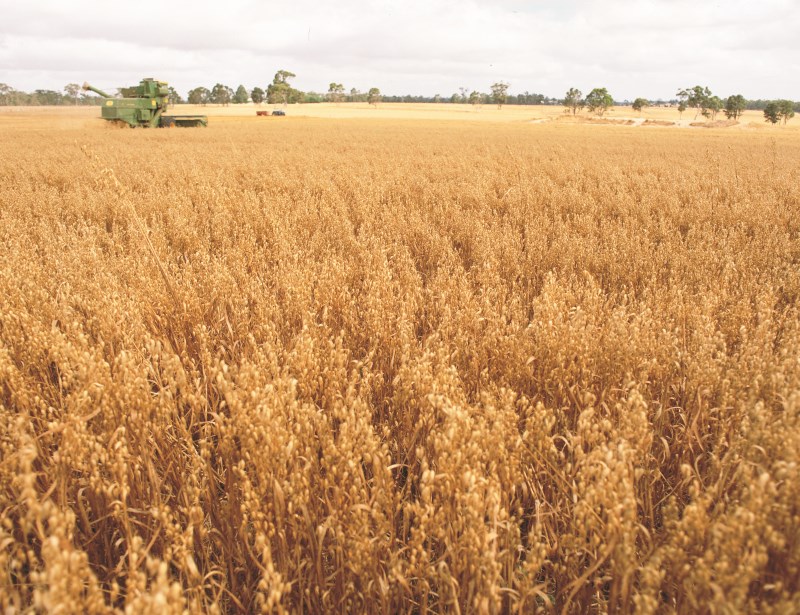
How Oatmeal Grows
Oats are an annual plant.
In other words, their life cycle will be complete within a year.
The most popular types of oat are white oats and red oats.
Oats plants should be planted in early spring.
Unlike rye or wheat, oats have a high tolerance for rain and a low requirement for heat.
In fact, oats need moist soil to properly germinate.
Oats take anywhere from 7 to 20 days to germinate and require full sun for the best yield.
Oat plants are harvested by cutting the plants 4 inches above the ground.
The plant will then be left to be dried and baled.
Varieties
Oatmeal may be a staple for breakfast, but did you know there are actually several different kinds of oatmeal available to purchase?
All oats begin the same way – as oat groats.
Before processing, oat groats are roasted at low temperatures.
The extent to which the oat groats are processed determines what type of oatmeal they’ll be.
Here are the most popular oatmeal varieties:
Instant Oats
Sometimes called ‘quick oats,’ instant oatmeal cooks faster than all other varieties.
Simply add hot water to instant oats, and they’ll be cooked within one or two minutes.
This variety of oatmeal has been pre-steamed and cut into tiny pieces.
Therefore, they’ll often yield a mushy texture and bland flavoring.
Steel-Cut Oats
When oat groats are cut into different pieces (instead of being rolled), they’re called steel-cut oats.
These oats (sometimes referred to as Scottish oats) are small in size, almost appearing like grains of rice.
This type of oat has a longer cook time. The texture of steel-cut oatmeal is often described as chewy, and it’ll maintain its shape even after it’s cooked.
Rolled Oats
Rolled oats are large, round, and flat in appearance.
This appearance is created during processing when the oats are steamed and flattened.
Rolled oats are often referred to as old-fashioned oats.
The cook time of these oats is quicker than steel-cut — because of the shape and density of rolled oats, which will absorb liquid more quickly.
Rolled oats are popularly used in baked goods and morning porridge.
Interesting Facts
Oats have been around for thousands of years, making them the world’s favorite breakfast grain.
Here are some interesting facts about oatmeal:
- The top three countries that produce oats are Russia, Canada, and Poland. However, the company that produces the most oats is in Cedar Rapids, Iowa—which is home to the most popular brand, Quaker Oats.
- National Oatmeal Day is October 29.
- However, National Oatmeal Month is January, when oatmeal sales are the highest.
- The Quaker Oats mascot has only been updated three times since its creation.
- A mere 18 ounces of oatmeal contains more than 26,000 oats.
- In the US, oatmeal is only 15 cents per serving.
- The Red Oat plant is native to China.
- Mountain bikers and BMX racers prefer using oatmeal as a healthy source of carbs — to keep their energy up throughout the day.
- A 1755 dictionary named The New Food Lover’s Companion listed oatmeal as only being suitable for horses in England, but suitable for human consumption in Scotland.
- Popular toppings for oatmeal include maple syrup, bananas, milk, peanut butter, and brown sugar.
- The Greeks were the first to use oatmeal as a hot breakfast cereal.
- Move aside, food carts. Oatmeal on-the-go has arrived. Every weekday morning, a Portland food cart called Bloop serves up unique flavors of warm oatmeal.
- Reportedly, only 5% of oatmeal is consumed by humans, with the rest going to livestock.
- The World Porridge Making Championship hosts oatmeal competitions every year.
- Besides cereal, oatmeal cookies are the #1 recipe that uses oats.
Nutritional Facts
Organic oatmeal has more nutritional value than oatmeal, which comes in packets.
Organic oatmeal contains 68 calories per 100-gram serving, while prepackaged Quaker Oats oatmeal contains 367 calories per 100-gram serving.
More sugar and fat are also in packet oatmeal, as opposed to eating steak-cut or rolled oats.
Oats are considered an excellent source of low-cost protein (1).
Therefore, it’s an ideal breakfast cereal for those who live healthy, active lifestyles.
Oatmeal is also a good source of dietary lipids, and it contains more lipids than other cereals.
Lipids supply the body with (and store) energy (2), and they line the outer layer of healthy cells.
Here are nutritional facts, per 100-gram serving of oatmeal.
This list refers to organic oatmeal:
Total Fat – 1.4 g
Sodium – 49 mg
Saturated Fat – 0.2 g
Polyunsaturated Fat – 0.4 g
Monounsaturated Fat – 0.4 g
Trans Fat – 0 g
Potassium – 61 mg
Total Carbohydrate – 12 g
Dietary Fiber – 1.7 g
Sugar – 0.5 g
Protein – 2.4 g
When it comes to your daily value of vitamins and minerals, oatmeal contains:
Vitamin A – 8%
Vitamin C – 0%
Calcium – 8%
Iron – 33%
Vitamin D – 0%
Vitamin B-6 – 15%
Vitamin B-12 – 0%
Magnesium – 6%
Health Benefits of Oatmeal
If you think of oatmeal as a gloppy breakfast cereal that your grandparents used to eat, you have yet to experience the real benefits of regularly eating oats.
Oatmeal can be made sweet or savory, and there are dozens of health benefits that come from incorporating oatmeal into your diet.
Here are 30 health benefits of oatmeal.
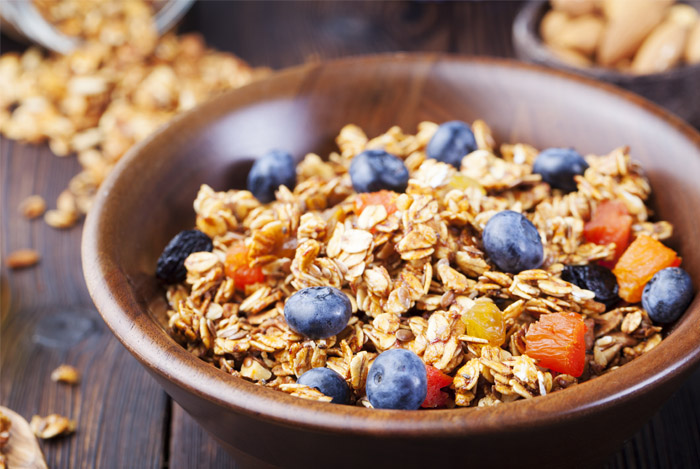
Rich in Antioxidants
Oatmeal is full of antioxidants, which are designed to keep your body healthy (3).
Antioxidants are essential to a healthy diet.
They protect the body from harmful molecules called free radicals (or oxidants).
These antioxidants contain many different vitamins and minerals (such as vitamins E and C and the mineral selenium).
Oxidants are created by your body to fight against harmful microbes and viruses.
However, if the body has an overflow of oxidants, they’ll begin to attack the cells.
Antioxidants will halt this process and protect cells against damage.
Relieves Constipation
Fiber is essential for getting things moving in your intestines.
People suffering from bowel issues will find relief in the form of oatmeal (4).
It contains 8 grams of soluble and insoluble fiber per cup.
The insoluble fiber found in oatmeal will absorb water that will then swell the trapped stool.
Once the stool is swollen with water, it will become soft and easier to pass.
To relieve constipation, slowly increase your fiber intake.
Then you’ll avoid unnecessary gas, bloating, and diarrhea (5).
Be sure to drink plenty of water.
Improves Insulin Sensitivity
Oatmeal may improve your body’s sensitivity to insulin (6), which is a pancreas-produced hormone that serves many purposes in the body.
One such purpose is to transform carbohydrates into energy.
Insulin also serves a vital function in your metabolism.
Having an insulin sensitivity means that you have a low resistance to insulin.
That’s a good thing, especially if you’re dealing with diabetes.
Oatmeal contains a low glycemic index, which will help level and maintain troublesome glucose levels (7).
Having oatmeal in your diet may reduce the amount of insulin you need (although this does not apply to prepackaged, flavored oatmeal).
If you suffer from diabetes, it’s time to add oatmeal to your diet (8).
May Help Prevent Diabetes
Diabetes is a metabolic disease, which raises blood glucose levels and may lead to blurred vision, frequent urination, and fatigue (9).
Diabetes can also lead to more serious conditions, such as nerve or kidney damage, cardiovascular issues, stroke, and hearing impairments.
Oats are high in fiber. Studies show that a high-fiber diet may reduce your risk of diabetes by over 30%.
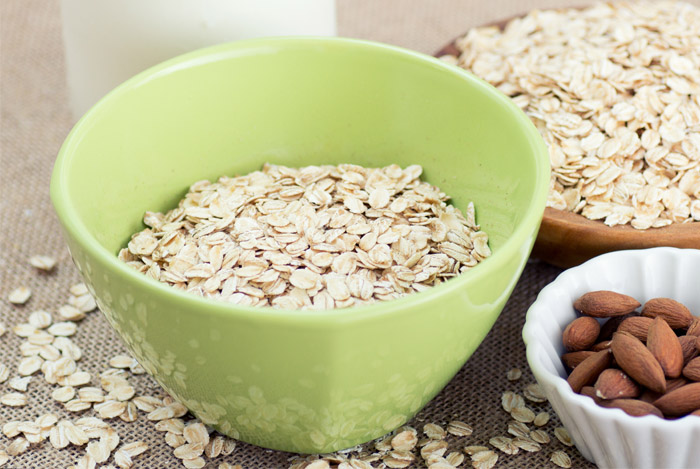
Provides Energy Boost
Oatmeal is a common favorite breakfast of bodybuilders and athletes, because of its energy-boosting capabilities (10).
Oats contain complex carbohydrates and are full of protein, which will fill the body with energy (without crashing).
Whole grains are slowly absorbed in the body, which means you’ll feel full for a longer period of time.
This benefit is especially important for daily exercise, as the body will not feel as worn out after you exercise.
Oatmeal contains thiamin, niacin, and folate.
This B-vitamins help metabolize energy and give the body the boost it needs to stay energized and motivated throughout the day.
Assists in Hemoglobin Formation
Each serving of oatmeal contains a healthy dose of iron, which is essential for hemoglobin formation.
Hemoglobin is a protein contained in red blood cells.
These molecules will carry oxygen around the body and return carbon dioxide from the tissues to the lungs.
A low hemoglobin count may lead to numerous health issues (11).
Lowers Cholesterol Levels
High cholesterol is a major health concern, and it can lead to serious conditions (such as heart attack, stroke, and heart disease).
Oatmeal is rich in soluble fiber, which lowers LDL (or “bad” cholesterol) (12).
Soluble fiber can also reduce cholesterol absorption into the bloodstream.
Helps Improve Muscle Mass
If you’re looking to bulk up your figure (or simply improve your muscle mass), try starting your morning with a bowl of steel-cut oats.
Oatmeal is an excellent source of healthy carbohydrates because it contains a low glycemic index (12), which means it will encourage fat loss and preserve muscles during workouts.
Oatmeal is a favorite of those counting their daily macros.
Just a 1/2 cup of steel-cut oats contains 5 grams of protein, 27 grams of carbs, 2 grams of fat, and plenty of fiber.
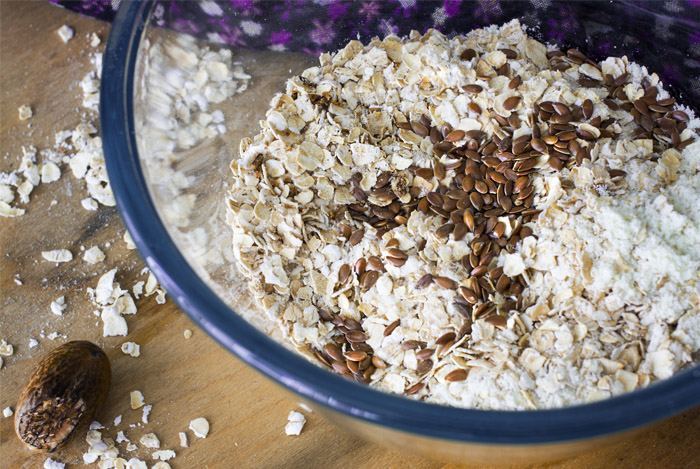
Helps with Weight Loss
Since oats are classified as carbohydrates, some feel that they should be avoided when trying to lose weight.
However, the opposite is true.
Oatmeal has a high nutritional value, spreads energy, and can help aid in your weight-loss journey.
Oatmeal’s soluble fibers take a long time to break down in the body, in comparison to other breakfast foods.
Because oatmeal contains healthy carbohydrates, they’ll keep you feeling full and satisfied.
Oatmeal has little to no impact on your blood sugar levels.
What really makes it such excellent support for weight loss is its resistance to starch.
In other words, your body will be triggered to release digestive acids that accelerate the calories burned during activity.
Oatmeal also stimulates your metabolism, which aids with weight loss (13).
Assists with Muscle Recovery
Carbohydrates and proteins are essential for building and recovering muscles (14).
Oatmeal contains both protein and complex carbohydrates.
The body uses these carbs to build muscle.
Iron is also found in oatmeal.
It’s an essential mineral for carrying oxygen through the bloodstream to the muscles.
The carbohydrates found in oatmeal turn into energy.
The body will then burn off this energy during a workout, instead of burning away your hard-earned muscle mass.
Decreases the Risk of Asthma in Children
Asthma affects more than 22 million Americans, and it’s one of the most common diseases in children (15).
This chronic disease has a direct effect on the airway and lungs.
Side effects of this disorder include breathing sensitivity to extreme heat and cold, wheezing, inflammation of the airway, coughing, chest pain, and shortness of breath.
One study revealed that introducing oats to the diets of children before the age of 6 months may actually decrease the risk of asthma (16).
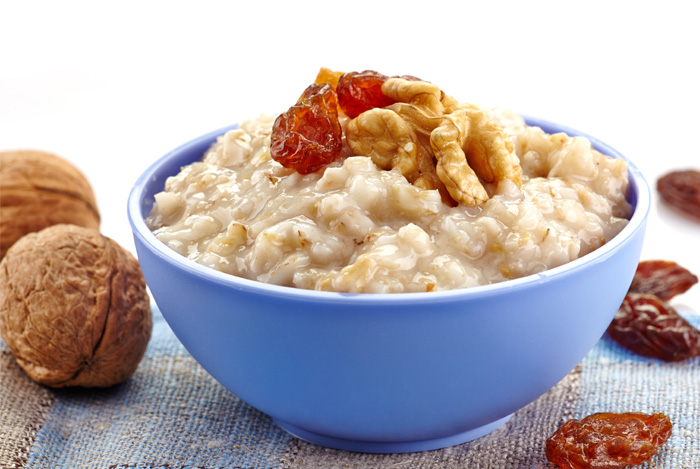
Rich in Protein
Protein is essential for a healthy human body.
The recommended daily intake of protein is anywhere from 46-57 grams per day, depending on age and gender.
Nails, hair, bone, skin, blood, and muscles all makeup protein.
Protein also aids in tissue repair and the production of hormones and enzymes.
Protein assists every single cell found in the body.
One cup of dry oatmeal contains 12 grams of protein, which makes it a perfect addition to your diet.
Assists in Estrogen Balance
You can balance your hormones by adding oatmeal into your diet (17).
Symptoms of a hormone imbalance or decrease include mental distractions, low libido, fogginess, anxiety, depression, hot flashes, weight gain, and fatigue.
Oatmeal is high in fiber. Fiber binds itself to estrogen and eliminates excess or unnecessary hormones.
Promotes Good Vision
Vitamin A is made up of antioxidant compounds.
These compounds are essential for bone formation, the immune system, and vision.
The cornea (or surface of the eye) is protected by vitamin A (18).
This vitamin creates barriers against viruses and bacteria, which can cause eye infections.
Vitamin A can also be an effective treatment for dry eyes.
In addition, some studies suggest that this vitamin plays a part in decreasing the risk of macular degeneration, which causes vision loss.
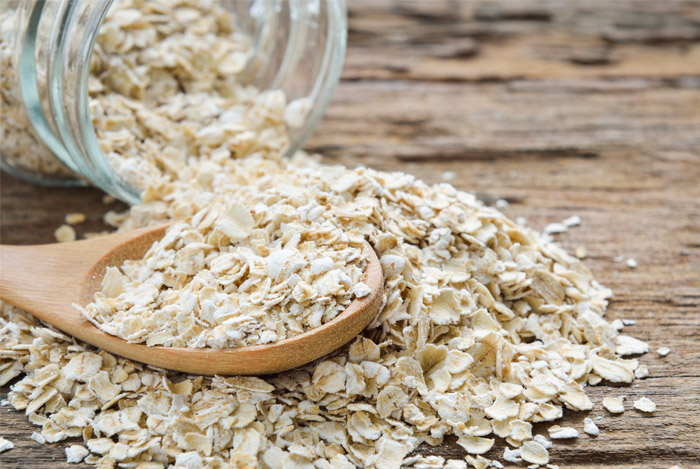
Helps Improve your Mood
Research shows that your diet may have a direct effect on your mood.
Eating junk food can actually cause depression.
However, oatmeal may combat depression and improve your mood.
It contains healthy carbs, which stimulate serotonin production.
Serotonin is a neurotransmitter produced by tryptophan.
This transmitter has a direct effect on your appetite, impulse control, sleep, and mood elevation (19).
Wards off Muscle Disorders
Oatmeal contains 61 mg of potassium per 100-gram serving.
Commonly associated with bananas, potassium is required for the healthy contraction of muscles.
Ions released by potassium are found in muscle cells.
These ions assist with reflexes, as well as the functions in the brain and nervous system related to muscles (20).
Removes Excess Carbon Dioxide
The recommended daily intake of sodium in a healthy adult is 1500 mg.
Oatmeal contains 49 mg of sodium per 100 grams.
Sodium is essential for removing excess carbon dioxide in the body, which can result in respiratory problems (21), damage to the nervous system, hypercapnia, and cell damage.
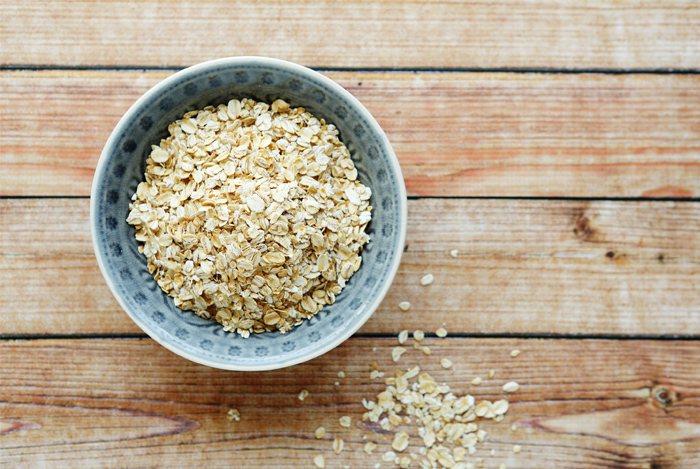
Helps Prevent Migraines
Studies show that those who suffer from chronic migraines often show lower levels of magnesium than those who do not.
Therefore, a healthy balance of magnesium may help prevent migraines (22).
Magnesium is one of the Top 5 most plentiful minerals found in the body, and it’s essential for proper nerve function.
One cup of cooked oatmeal contains 15% of the daily recommended intake of magnesium.
Assists in Reproduction
Eating oatmeal every day can give your body a healthy libido, sex organs, and reproductive glands.
The body’s lack of vitamin A may cause atrophy of the ovaries and a decrease in the production of sex hormones in both males and females.
Vitamin A is especially essential for male reproduction.
A deficiency of this vitamin can have a direct effect on spermatogonial differentiation and the shrinkage of the testicles (23).
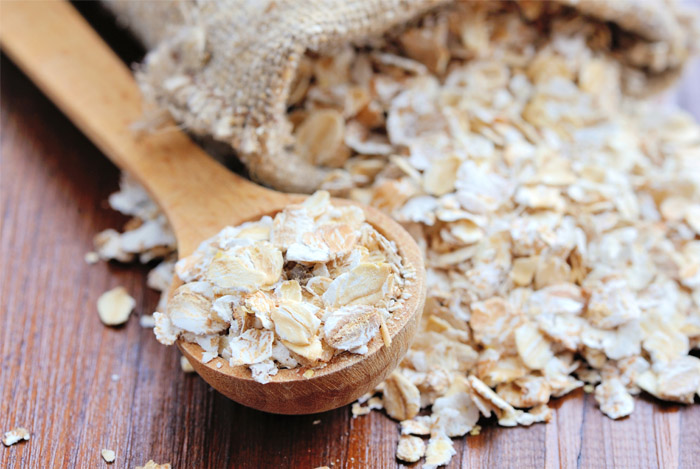
Reduces Blood Pressure
High blood pressure is a serious issue that plagues many people.
High blood pressure may lead to heart attack, heart failure, heart disease, and a buildup in the arteries.
More than 20 studies conducted (about the effects that fiber has on blood pressure) found that those practicing a high-fiber diet saw a significant reduction in blood pressure (24).
Fights Anemia
Oatmeal is full of iron, which can help combat anemia (25).
Anemia happens when your body lacks red blood cells.
Symptoms of anemia include fatigue, pale complexion, swelling of the tongue, tingling in the legs, shortness of breath, dizzy spells, and headaches.
Oatmeal Prevents Overeating
If you find yourself constantly feeling hungry, oatmeal may be your best bet for preventing overeating (26).
Oatmeal contains a compound called beta-glucan.
This compound stimulates a hormone called cholecystokinin, which is responsible for making your body feel full.
Because oatmeal is rich in protein and fiber, it will help you feel fuller for a longer period of time.
This impact will help prevent overeating during your next meal because your body will still feel satisfied and energized.
Treatment of PMS
Oatmeal contains vitamin B-6, which is effective at relieving symptoms of premenstrual syndrome (PMS) (27).
This vitamin can help combat mood disorders associated with PMS because Vitamin B6 helps the body produce amino acid transmitters (such as dopamine and melatonin).
These key components determine your behavior and mood.
A daily helping of vitamin B-6 can help reduce moodiness and depression that are commonly associated with PMS.
Effective Acne Treatment
Oatmeal diminishes excess oils in the skin without clogging pores.
Therefore, it’s a great natural remedy for combating acne (28).
Regulates Electrolyte Balance
If you’ve ever had a sports drink, you probably know that electrolytes are important for staying hydrated.
Electrolytes are made up of magnesium, potassium, sodium, calcium, chloride, and phosphate.
The function of electrolytes includes contracting your muscles, regulating your heartbeat, and balancing the fluid levels of your cells.
When your body has an imbalance of electrolytes, you may experience fatigue, nausea, cramping, irregular heartbeat, and headaches.
Oatmeal contains substantial potassium, and it can help regulate your electrolyte balance (29).
Reduces the Risk of Coronary Heart Disease
In addition to fighting to overeat, the beta-glucan in oatmeal may reduce the risk of coronary heart disease (30).
A 19-year study in the Archives of Internal Medicine revealed that fiber-rich foods can help prevent heart disease (31).
Participants were shown to have a significantly lower chance of developing coronary heart disease.
Soothes Eczema
Eczema is a skin condition that involves chronic inflammation.
Sometimes referred to as atopic dermatitis, eczema symptoms include itchy red skin with a rash-like appearance.
Those suffering from eczema may find breakouts anywhere on the body.
Oatmeal isn’t just good when ingested.
This whole grain is also beneficial when topically applied to the skin.
Whether you suffer from allergic reactions or skin conditions, oatmeal may sooth your skin.
The antimicrobial ingredients found in oatmeal can inhibit bacteria growth (32).
Combine a cup of steel-cut oatmeal or colloidal oatmeal powder into warm bathwater.
Soak in the bath, and let the oatmeal wash over your skin.
You can also mix oatmeal into a paste with hot water, and apply it topically.
To soothe the irritation caused by eczema, combine 1/3 cup of oatmeal, 1/2 cup of hot water, a tablespoon of honey, and a tablespoon of Greek yogurt into a bowl.
Then mix it up, and apply it to your face.
Lowers Risk of Stroke
American diets lack Potassium.
This mineral protects your body by preventing oxidative damage to your blood vessels and keeping your blood-vessel walls at an appropriate thickness (33).
Potassium reduces the effect that salt has on the body.
For instance, it can prevent high blood pressure, which could lead to a stroke (34).
Studies suggest that lowering your salt intake and increasing your potassium intake can reduce the risk of stroke by up to 21%.
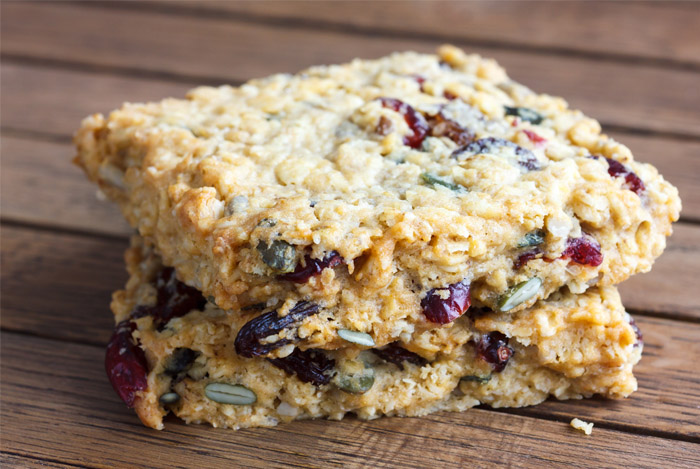
Reduces the Risk of Colon Cancer
As a whole grain, oatmeal is a big contender in the fight against cancer (35).
Oatmeal contains selenium, which is an antioxidant that repairs and protects cells against damage.
So antioxidants help repair DNA and fight cancerous cells (36).
Therefore, oatmeal may help lower the risk of cancer, particularly colon cancer.
Assists in Brain Function
Oatmeal contains 6mg of iron per 100-gram serving.
Iron is essential for healthy brain function (37) because it supplies oxygen to the bloodstream.
This oxygen is transferred throughout the body (from cell to cell) to perform basic bodily functions.
The brain uses 20% of this oxygen in its functions.
Therefore, it helps the brain stay alert and increases physical performance in the body.
Iron also heavily contributes to brain health in developing infants.
How to Buy and Store
Having healthy oatmeal fresh on hand means properly choosing and storing it.
Below we’ll look at how to buy oatmeal, and how to store both cooked and uncooked oats.
How to Buy Oatmeal
When buying oatmeal, determine which kinds of oats you want to purchase: rolled, steel-cut, quick, or instant.
What’re you using your oats for?
Different forms of oatmeal have different cook times, shelf lives, and nutritional values.
The longer the shelf life of oats, the longer they’ll take to prepare.
For a healthier option, stick to organic, bagged oatmeal (as opposed to prepackaged, flavored oatmeal).
Oatmeal is found in most local grocery stores, and it can be purchased at farmers’ markets.
Storing Cooked Oats
Cooked oats can keep in the refrigerator for up to five days.
Store your cooked oats in a sealed container or plastic bag.
Once you’re ready, simply reheat and serve.
You may also choose to freeze your cooked oats and eat them at a later date.
Simply separate into desired portions, and store in an air-tight container.
Cooked oats will keep for 3 months in the freezer.
Defrost and reheat before serving.
Storing Uncooked Oats
Steel-cut oats are a whole grain, which means they contain oil that can spoil if improperly stored.
Store oats in a tightly sealed container (plastic or glass), and set them in a clean, dry pantry.
Storing them with a tight-fitting lid will protect them from infestation (such as rodents or weevils).
If you normally keep oats in your pantry for more than two months, you may want to consider freezing them.
Then you’ll prevent the oats from spoiling for up to 4 months.
You can also store sealed oats in your refrigerator for up to 3 months.
How to Incorporate More Oats into Your Diet
Given the vast health benefits of oats, your body will only benefit from having more oatmeal in your diet.
Even if you don’t like porridge, you’ll be able to find a way to incorporate healthy oats into any meal (sweet or savory).
Here are 6 ways to get more oats into your diet:
Hot Porridge
Hot porridge is one of the easiest, most popular ways to eat oatmeal.
Whether you’re boiling the oats with a kettle, over the stove, or in the oven, hot oatmeal is a fast, easy, healthy option for breakfast.
Overnight Oats
Make overnight oats by mixing a half a cup of rolled oats with 1 tablespoon of chia seeds, a pinch of salt, 1/2 teaspoon of vanilla extract, 1/3 cup of Greek yogurt, and 2/3 cup of milk.
Mix these items together, and leave it sealed in the fridge overnight.
Then you’ll have a glorious breakfast that tastes more like a smooth, delicious pudding (rather than lumpy oatmeal).
Add in your own ingredients (such as blueberries, pumpkin puree, raisins, cinnamon, or cooked apples) to spice up your flavor profile.
With Proteins
Incorporate whole or ground oats into savory dishes (such as meatloaf, homemade meatballs, hamburgers, and stew), or use them as a crust for chicken breasts.
This technique adds extra nutrients to your proteins.
Smoothies
One of the easiest ways to reap the health benefits of oatmeal is to blend it into your morning or post-workout smoothie.
Simply add a few teaspoons, and blend to perfection.
Experiment with blended oats and hot water, which will make oat milk.
Desserts
Baking allows for myriads of oatmeal-inspired recipes for you to nibble on when your sweet tooth is acting up.
Oatmeal cookies, blueberry oatmeal muffins, and oat bread are just some of the delicious options for getting more oats in your diet.
Cocktails
There are several cocktails that use oats to their advantage.
One such recipe is oat and honey vodka.
Just combine 3/4 cup raw honey, 2 cups of rolls oats, and 1 liter of vodka in a container.
Leave in the fridge for five days, strain, and serve.
Serve on the rocks, in coffee, or blended with cream.
Precautions
Oatmeal is rich in nutrients, and it’s an excellent part of a balanced diet.
While oatmeal is generally safe for consumption, some may experience mild side effects from oat ingestion.
Here are the most common side effects.
Gas
Some have cited bloating and intestinal gas as a side effect of taking oatmeal.
It’s rich in high-soluble fiber, which can lead to painful gas (38).
To avoid gas associated with oatmeal, begin by eating small portions.
Then slowly increase the amount ingested over time.
Gassy side effects will eventually go away.
Allergic Reaction
People who experience oat intolerance may have an inflammatory response and flu-like (but not life-threatening) symptoms.
Oat allergies are very rare.
Those who have gluten intolerance may also find that their bodies respond poorly to oats (39).
Side effects of eating oatmeal with gluten intolerance include cramping, bloating, diarrhea, joint pain, rashes, and brain fog.
If you suffer from oat intolerance, you should avoid porridge, muesli, cereal bars, oat milk, beer, and oat bread.
Avoid Prepackaged Oatmeal
Flavored, prepackaged oatmeal may contribute to an increased risk of diabetes (due to high volumes of sugar).
Stick to organic oats that you make yourself.
Other Precautions
If not chewed thoroughly, oats can cause intestinal blockage.
Also, gas pains associated with high-fiber oatmeal may cause further discomfort to those suffering from digestive issues (such as irritable bowel syndrome) (41), (41).
Therefore, those with ongoing digestive issues shouldn’t consume oatmeal.
Those who have trouble chewing or swallowing food (perhaps due to medical conditions) should avoid consuming oatmeal.
Oatmeal may also be difficult to eat for people who wear dentures or have missing teeth.
Conclusion
Old or young, active or average, oatmeal boasts an impressive profile.
Oatmeal is an affordable, delicious food, and it’s jam-packed with nutrients that are good for the body and mind.
Those who lead an active lifestyle will benefit from a daily dose of oatmeal.
Oatmeal has a long shelf life (both in the pantry and the freezer) as long as it’s stored in an air-tight container.
Whether you’re looking to get more fiber in your diet or simply want to take advantage of the many health benefits of oatmeal, this grain is definitely worth having on hand.
FDA Compliance
The information on this website has not been evaluated by the Food & Drug Administration or any other medical body. We do not aim to diagnose, treat, cure or prevent any illness or disease. Information is shared for educational purposes only. You must consult your doctor before acting on any content on this website, especially if you are pregnant, nursing, taking medication, or have a medical condition.
HOW WOULD YOU RATE THIS ARTICLE?
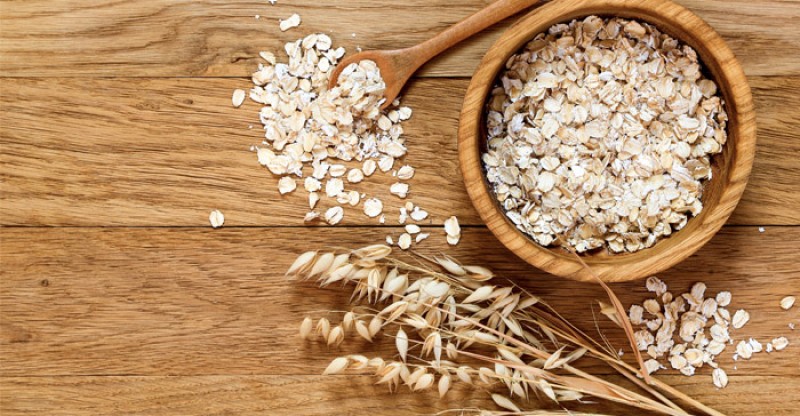



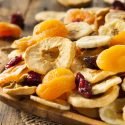
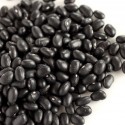
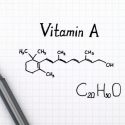
Are oatmeal snack bars also beneficial for health?
Can I eat oatmeal porridge in the evening or it’s better eaten for breakfast?
Oatmeal as an acne treatment should be eaten or applied on the affected areas?
Hi, thank you a lot for these scientific informations, you gave me inspiration to write an article about oats in my website (in Arabic language).
lol I was eating a bowl of oats while reading this article. I really love and appreciate the knowledge I have just gained from this post, please continue to keep up the remarkable work.